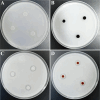Novel gut bacteria species Paenibacillus ilasis with phosphorus degrading and soluble starch hydrolysis abilities isolated from fresh feces of rhinoceros
- PMID: 40596264
- PMCID: PMC12219264
- DOI: 10.1038/s41598-025-06760-w
Novel gut bacteria species Paenibacillus ilasis with phosphorus degrading and soluble starch hydrolysis abilities isolated from fresh feces of rhinoceros
Abstract
The genus Paenibacillus, known for its diverse sources, is a valuable reservoir of antimicrobial compounds, enzymes and other valuable chemicals, with applications in medicine, agriculture, and bioremediation. Despite this, Paenibacillus strains, particularly those isolated from unique environments, remain underexplored, limiting our understanding of their potential, capabilities and taxonomic classifications. The gut microbiome of large herbivores, such as rhinoceroses, harbors underexplored microbial diversity with unique metabolic capabilities. In this study, a Gram-stain-negative, facultatively aerobic, motile, spore-forming, rod-shaped bacterial strain, NGMCC 1.200843T (= CGMCC 1.64763T = JCM 37214T), was isolated from fresh rhinoceros feces and characterized its taxonomic status and metabolic potential. Phylogenetic, phenotypic, and chemotaxonomic analyses confirmed the isolate as a novel species within the genus Paenibacillus, closely related to Paenibacillus lautus DSM 3035T (98.62% 16S rRNA gene similarity). The average nucleotide identity (ANI) and the digital DNA-DNA hybridization values were below the threshold for species delineation. The major cellular fatty acids were anteiso-C15:0, C16:0 and iso-C16:0 (> 10%) and the polar lipid profile contained diphosphatidylglycerol (DPG), phosphatidylglycerol (PG), phosphatidylethanolamine (PE), two unidentified phospholipids (PL1-2) and one phosphatidyl choline (PC). The total DNA G + C content was 49.69 mol%. The isolate exhibited significant phosphate solubilization and starch hydrolysis activities in plate assays, suggesting a role in nutrient cycling within the rhinoceros gut. We propose the name Paenibacillus ilasis sp. nov. for this strain. These findings enhance our understanding of gut microbial diversity in herbivores and lay the foundation for future applications in agriculture or industry.
Keywords: Paenibacillus ilasis sp. nov.; Organophosphorus solubilization; Polyphasic taxonomy; Soluble starch hydrolysis.
© 2025. The Author(s).
Conflict of interest statement
Declarations. Competing interests: The authors declare no competing interests. Ethics approval and consent to participate: There are no animal subjects in this article and informed consent is not applicable.
Figures







Similar articles
-
Description of Paenibacillus jiagnxiensis sp. nov., a mesotrione-degrading bacterium isolated from farmland and cloning of a novel mesotrione nitroreductase gene.Antonie Van Leeuwenhoek. 2025 Jun 29;118(8):98. doi: 10.1007/s10482-025-02114-8. Antonie Van Leeuwenhoek. 2025. PMID: 40581877
-
Phylotaxonomic analysis uncovers underestimated species diversity within the genus Rossellomorea with description of selenium-resistant Rossellomorea yichunensis sp. nov.BMC Microbiol. 2025 Jul 3;25(1):408. doi: 10.1186/s12866-025-04138-6. BMC Microbiol. 2025. PMID: 40610858 Free PMC article.
-
Genomic and taxonomic characterization of Niallia pakistanensis sp. nov. NCCP-28T: a novel antibiotic-resistant and heavy-metal-tolerant bacterium isolated from the legume rhizosphere in Pakistan.Antonie Van Leeuwenhoek. 2025 Jul 23;118(9):122. doi: 10.1007/s10482-025-02132-6. Antonie Van Leeuwenhoek. 2025. PMID: 40702293
-
Paenibacillus hubeiensis sp. nov.: A Novel Selenium-Resistant Bacterium Isolated from the Rhizosphere of Galinsoga parviflora in a Selenium-Rich Region of Enshi, Hubei Province.Microorganisms. 2025 Jul 2;13(7):1559. doi: 10.3390/microorganisms13071559. Microorganisms. 2025. PMID: 40732068 Free PMC article.
-
Paenibacillus peoriae: current knowledge and agricultural biotechnology potential of a close relative of P. polymyxa.Antonie Van Leeuwenhoek. 2025 Jul 23;118(9):120. doi: 10.1007/s10482-025-02135-3. Antonie Van Leeuwenhoek. 2025. PMID: 40699473 Free PMC article. Review.
References
-
- Ash, C., Priest, F. G. & Collins, M. D. Molecular identification of rRNA group 3 bacilli (Ash, Farrow, Wallbanks and Collins) using a PCR probe test. Antonie Van Leeuwenhoek64, 253–260. 10.1007/BF00873085 (1993). - PubMed
-
- Yuan, P. et al. Microbial cell factories using Paenibacillus: status and perspectives. Crit. Rev. Biotechnol.44, 1386–1402. 10.1080/07388551.2023.2289342 (2024). - PubMed
MeSH terms
Substances
Grants and funding
LinkOut - more resources
Full Text Sources
Medical

